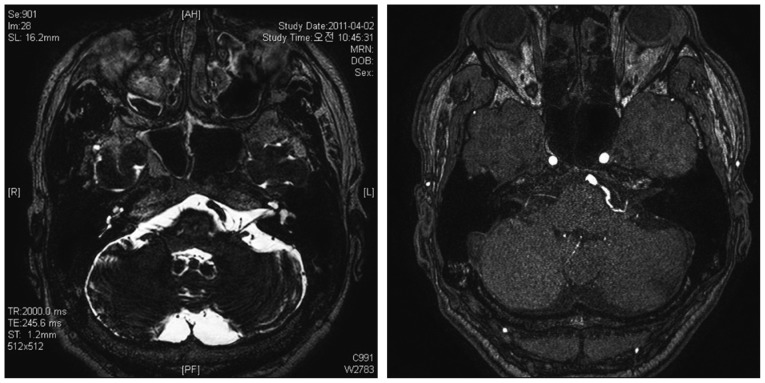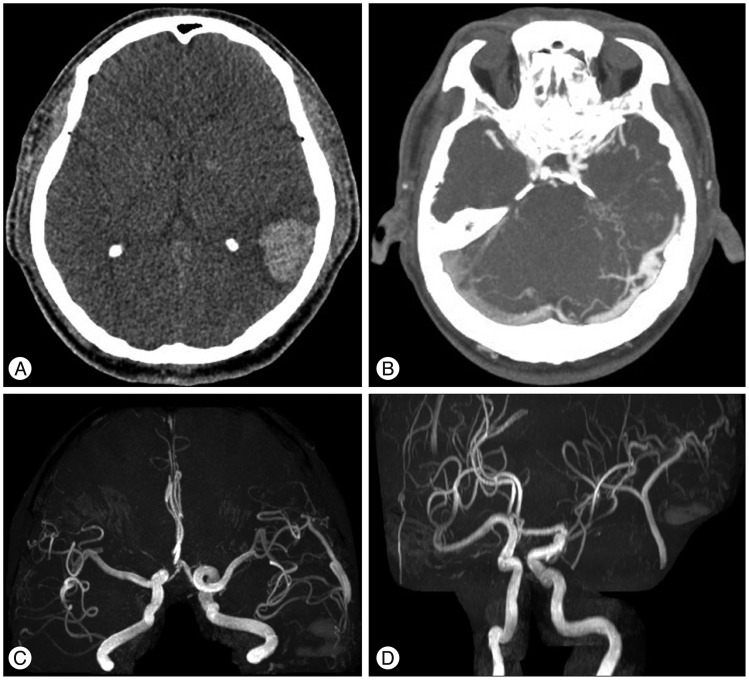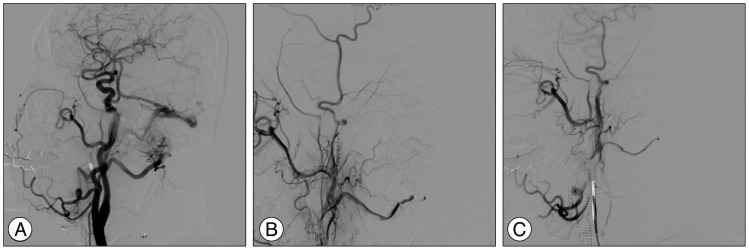1. Bink A, Berkefeld J, Kraus L, Senft C, Ziemann U, du Mesnil de Rochemont R. Long-term outcome in patients treated for benign dural arteriovenous fistulas of the posterior fossa. Neuroradiology. 2011; 53:493–500. PMID:
20737143.

2. Brown RD Jr, Wiebers DO, Nichols DA. Intracranial dural arteriovenous fistulae : angiographic predictors of intracranial hemorrhage and clinical outcome in nonsurgical patients. J Neurosurg. 1994; 81:531–538. PMID:
7931586.

3. Caragine LP, Halbach VV, Dowd CF, Ng PP, Higashida RT. Parallel venous channel as the recipient pouch in transverse/sigmoid sinus dural fistulae. Neurosurgery. 2003; 53:1261–1266. discussion 1266-1267. PMID:
14633292.

4. Chaudhary MY, Sachdev VP, Cho SH, Weitzner I Jr, Puljic S, Huang YP. Dural arteriovenous malformation of the major venous sinuses : an acquired lesion. AJNR Am J Neuroradiol. 1982; 3:13–19. PMID:
6800236.
5. Cognard C, Gobin YP, Pierot L, Bailly AL, Houdart E, Casasco A, et al. Cerebral dural arteriovenous fistulas : clinical and angiographic correlation with a revised classification of venous drainage. Radiology. 1995; 194:671–680. PMID:
7862961.

6. Gardner WJ, Sava GA. Hemifacial spasm-a reversible pathophysiologic state. J Neurosurgery. 1962; 19:240–247.

7. Hanaoka M, Matsubara S, Satoh K, Nagahiro S. Dural arteriovenous fistulae after cerebral infarction : report of two cases. Neurosurgery. 2011; 68:E575–E579. discussion E580. PMID:
21135717.
8. Houser OW, Baker HL Jr, Rhoton AL Jr, Okazaki H. Intracranial dural arteriovenous malformations. Radiology. 1972; 105:55–64. PMID:
5057316.

9. Jannetta PJ, Abbasy M, Maroon JC, Ramos FM, Albin MS. Etiology and definitive microsurgical treatment of hemifacial spasm. Operative techniques and results in 47 patients. J Neurosurg. 1977; 47:321–328. PMID:
894338.
10. Jiang C, Lv X, Li Y, Wu Z. Transarterial Onyx packing of the transverse-sigmoid sinus for dural arteriovenous fistulas. Eur J Radiol. 2011; 80:767–770. PMID:
21030176.

11. Kida Y. Radiosurgery for dural arteriovenous fistula. Prog Neurol Surg. 2009; 22:38–44. PMID:
18948718.

12. Kim JP, Chung JC, Chang WS, Chung SS, Chang JW. Outcomes of surgical treatment for hemifacial spasm associated with the vertebral artery : severity of compression, indentation, and color change. Acta Neurochir (Wien). 2012; 154:501–508. PMID:
22160400.

13. Kimura T, Shojima M, Koizumi T, Fukaya S, Ichikawa Y, Morita A. Surgical treatment of a dural arteriovenous fistula in the superior petrosal sinus of an elderly patient with minimal suboccipital craniotomy : case report. Neurol Med Chir (Tokyo). 2009; 49:465–467. PMID:
19855143.

14. Loumiotis I, Lanzino G, Daniels D, Sheehan J, Link M. Radiosurgery for intracranial dural arteriovenous fistulas (DAVFs) : a review. Neurosurg Rev. 2011; 34:305–315. discussion 315. PMID:
21584687.

15. Lv X, Jiang C, Li Y, Liu L, Liu J, Wu Z. The limitations and risks of transarterial Onyx injections in the treatment of grade I and II DAVFs. Eur J Radiol. 2011; 80:e385–e388. PMID:
20837384.

16. Lv X, Jiang C, Li Y, Wu Z. Embolization of intracranial dural arteriovenous fistulas with Onyx-18. Eur J Radiol. 2010; 73:664–671. PMID:
19144481.

17. Miller LE, Miller VM. Safety and effectiveness of microvascular decompression for treatment of hemifacial spasm : a systematic review. Br J Neurosurg. 2012; 26:438–444. PMID:
22168965.

18. Nabors MW, Azzam CJ, Albanna FJ, Gulya AJ, Davis DO, Kobrine AI. Delayed postoperative dural arteriovenous malformations. Report of two cases. J Neurosurg. 1987; 66:768–772. PMID:
3572502.
19. Sakaki T, Morimoto T, Nakase H, Kakizaki T, Nagata K. Dural arteriovenous fistula of the posterior fossa developing after surgical occlusion of the sigmoid sinus. Report of five cases. J Neurosurg. 1996; 84:113–118. PMID:
8613817.

20. Schaller B. Trigeminocardiac reflex. A clinical phenomenon or a new physiological entity? J Neurol. 2004; 251:658–665. PMID:
15311339.
21. Sundt TM Jr, Piepgras DG. The surgical approach to arteriovenous malformations of the lateral and sigmoid dural sinuses. J Neurosurg. 1983; 59:32–39. PMID:
6864280.

22. Watanabe A, Takahara Y, Ibuchi Y, Mizukami K. Two cases of dural arteriovenous malformation occurring after intracranial surgery. Neuroradiology. 1984; 26:375–380. PMID:
6544379.








 PDF
PDF ePub
ePub Citation
Citation Print
Print


 XML Download
XML Download